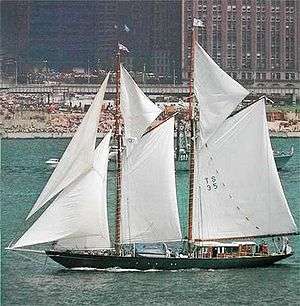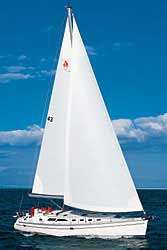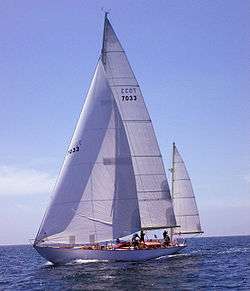Sailboat

A sailboat or sailing boat is a boat propelled partly or entirely by sails smaller than a sailing ship. Distinctions in what constitutes a sailing boat and ship vary by region and maritime culture.
Types
Although sailboat terminology has varied across history, many terms have specific meanings in the context of modern yachting. A great number of sailboat-types may be distinguished by size, hull configuration, keel type, purpose, number and configuration of masts, and sail plan.
Popular monohull designs include:
Cutter

The cutter is similar to a sloop with a single mast and mainsail, but generally carries the mast further aft to allow for a jib and staysail to be attached to the head stay and inner forestay, respectively. Once a common racing configuration, today it gives versatility to cruising boats, especially in allowing a small staysail to be flown from the inner stay in high winds.
Catboat

A catboat has a single mast mounted far forward and does not carry a jib. Most modern designs have only one sail, the mainsail; however the traditional catboat could carry multiple sails from the gaff rig.
Dinghy
A dinghy is a type of small open sailboat commonly used for recreation, sail training, and tending a larger vessel. They are popular in youth sailing programs for their short LOA, simple operation and minimal maintenance. They have three (or fewer) sails: the mainsail, jib, and spinnaker.
Ketch
Ketches are similar to a sloop, but there is a second shorter mast astern of the mainmast, but forward of the rudder post. The second mast is called the mizzen mast and the sail is called the mizzen sail. A ketch can also be Cutter-rigged with two head sails.
Schooner

A schooner has a mainmast taller than its foremast, distinguishing it from a ketch or a yawl. A schooner can have more than two masts, with the foremast always lower than the foremost main. Traditional topsail schooners have topmasts allowing triangular topsails sails to be flown above their gaff sails; many modern schooners are Bermuda rigged.
Sloop

The most common modern sailboat is the sloop, which features one mast and two sails, typically a Bermuda rigged main, and a headsail. This simple configuration is very efficient for sailing into the wind.
A fractional rigged sloop has its forestay attached at a point below the top of the mast, allowing the mainsail to be flattened to improve performance by raking the upper part of the mast aft by tensioning the backstay. A smaller headsail is easier for a short-handed crew to manage.
Yawl

A yawl is similar to a ketch, with a shorter mizzen mast carried astern the rudderpost more for balancing the helm than propulsion.
Hulls
Traditional sailboats are monohulls, but multi-hull catamarans and trimarans are gaining popularity. Monohull boats generally rely on ballast for stability, and usually are displacement hulls. This stabilizing ballast can, in boats designed for racing, be as much as 50% of the weight of the boat, but is generally around 30%. It creates two problems; one, it gives the monohull tremendous inertia, making it less maneuverable and reducing its acceleration. Secondly, unless it has been built with buoyant foam or air tanks, if a monohull fills with water, it will sink.
Multihulls rely on the geometry and the broad stance of the multiple hulls for their stability, eschewing any form of ballast. Indeed, multihulls are designed to be as light-weight as possible, yet maintain structural integrity. They are often built with foam-filled flotation chambers and many modern commercial trimarans are rated as unsinkable, meaning that, should every crew compartment be completely filled with water, the hull itself has sufficient buoyancy to remain afloat.
This absence of ballast also results in some very real performance gains in terms of acceleration, top speed, and maneuverability.
- The lack of ballast makes it much easier to get a multihull on plane, reducing its wetted surface area and thus its drag.The absence of drag improves wind precision, giving it its great handling.
- Compared to a monohull, acceleration to top speed is near-instantaneous.
- Reduced overall weight means a reduced draft, with a much reduced underwater profile. This, in turn, results directly in reduced wetted surface area and drag, yielding higher top speeds.
- Without a ballast keel, multihulls can go in shallow waters where monohulls can't.
There are some tradeoffs, however, in multihull design:
- A well designed ballasted boat can recover from a capsize, even from turning over completely. The Swan 65 Sayula II won the 1973-74 Whitbread Round the World Race after doing a 180 degree capsize in the Southern Ocean. Righting a multihull that has gotten upside down is difficult in any case and impossible without outside help unless the boat is small or carries special equipment for the purpose. Several round the world racing multihulls have been lost after they capsized.
- Multihulls often prove more difficult to tack, since the reduced weight leads directly to reduced momentum, causing multihulls to more quickly lose speed when headed into the wind.
- Also, structural integrity is much easier to achieve in a one piece monohull than in a two or three piece multihull whose connecting structure must be substantial and well connected to the hulls.
All these hull types may also be manufactured as, or outfitted with, hydrofoils.
Keel
All vessels have keels, it is the backbone of the hull. In traditional construction it is the structure upon which all else depends. Modern monocoque designs include a virtual keel. Even multihulls have keels. On a sailboat the word "keel" is also used to refer to the area that is added to the hull to improve its lateral plane. The lateral plane is what prevents leeway and allows sailing towards the wind. This can be an external piece or a part of the hull.
Most monohulls larger than a dinghy require ballast, depending on the design ballast will be 20 to 50 percent of the displacement. The ballast is often integrated into their keels as large masses of lead or cast iron. This secures the ballast and gets it as low as possible to improve its effectiveness. External keels are cast in the shape of the keel. A monohull's keel is made effective by a combination of weight, depth and length.

Most modern monohull boats have fin keels, which are heavy and deep, but short in relation to the hull length. More traditional yachts carried a full keel which is generally half or more of the length of the boat. A recent feature is a winged keel, which is short and shallow, but carries a lot of weight in two "wings" which run sideways from the main part of the keel. Even more recent is the concept of canting keels, designed to move the weight at the bottom of a sailboat to the upwind side, allowing the boat to carry more sails.
Multihulls, on the other hand, have minimal need for such ballast, as they depend on the geometry of their design, the wide base of their multiple hulls, for their stability. Designers of performance multihulls, such as the Open 60's, go to great lengths to reduce overall boat weight as much as possible. This leads some to comment that designing a multihull is similar to designing an aircraft.
A centreboard or daggerboard is retractable lightweight keel which can be pulled up in shallow water.
See also
- Boat building
- Boating
- Cruising (maritime)
- Land sailing
- Sailboat design and manufacturing
- Sailing (sport)
- Yacht racing
References
- Jim Howard; Charles J. Doane (2000). Handbook of offshore cruising: The Dream and Reality of Modern Ocean Cruising (2nd ed.). Dobbs Ferry, NY: Sheridan House, Inc. p. 36. ISBN 1-57409-093-3.
- C. A. Marchaj (2000). Aero-Hydrodynamics of Sailing (3rd ed.). Saint Michaels, MD: Tiller Publishing. ISBN 1-888671-18-1.
- C. A. Marchaj (2003). Sail Performance: Techniques to Maximize Sail Power (2nd revised ed.). Camden, km9ijh,uimyg0ME: International Marine/McGraw-Hill. ISBN 0-07-141310-3.
- C. A. Marchaj (1996). Seaworthiness: The Forgotten Factor (Revised ed.). Saint Michaels, MD: Tiller Publishing. ISBN 1-888671-09-2.
External links
| Look up sailboat in Wiktionary, the free dictionary. |
| Wikimedia Commons has media related to Sailboats. |
- SailboatData Sailboat database
- SailingtheWeb Sailboat database
- Basic sailing principles
- John's International Boats: Directory of Sailboats, Designers, Builders, Associations & More (15,000 entries)
- Web site of the International Sailing Federation